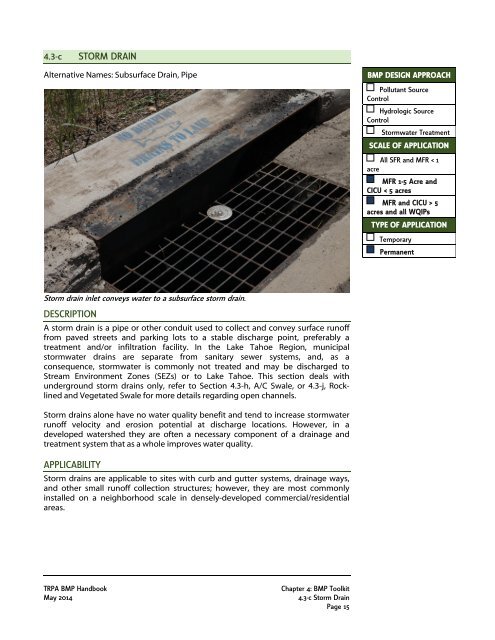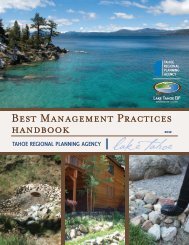4.3-c STORM DRAIN DESCRIPTION APPLICABILITY - Tahoe BMP
4.3-c STORM DRAIN DESCRIPTION APPLICABILITY - Tahoe BMP
4.3-c STORM DRAIN DESCRIPTION APPLICABILITY - Tahoe BMP
Create successful ePaper yourself
Turn your PDF publications into a flip-book with our unique Google optimized e-Paper software.
<strong>4.3</strong>-c<br />
<strong>STORM</strong> <strong>DRAIN</strong><br />
Alternative Names: Subsurface Drain, Pipe<br />
<strong>BMP</strong> DESIGN APPROACH<br />
Pollutant Source<br />
Control<br />
Hydrologic Source<br />
Control<br />
Stormwater Treatment<br />
SCALE OF APPLICATION<br />
All SFR and MFR < 1<br />
acre<br />
MFR 1-5 Acre and<br />
CICU < 5 acres<br />
MFR and CICU > 5<br />
acres and all WQIPs<br />
TYPE OF APPLICATION<br />
Temporary<br />
Permanent<br />
Storm drain inlet conveys water to a subsurface storm drain.<br />
<strong>DESCRIPTION</strong><br />
A storm drain is a pipe or other conduit used to collect and convey surface runoff<br />
from paved streets and parking lots to a stable discharge point, preferably a<br />
treatment and/or infiltration facility. In the Lake <strong>Tahoe</strong> Region, municipal<br />
stormwater drains are separate from sanitary sewer systems, and, as a<br />
consequence, stormwater is commonly not treated and may be discharged to<br />
Stream Environment Zones (SEZs) or to Lake <strong>Tahoe</strong>. This section deals with<br />
underground storm drains only, refer to Section <strong>4.3</strong>-h, A/C Swale, or <strong>4.3</strong>-j, Rocklined<br />
and Vegetated Swale for more details regarding open channels.<br />
Storm drains alone have no water quality benefit and tend to increase stormwater<br />
runoff velocity and erosion potential at discharge locations. However, in a<br />
developed watershed they are often a necessary component of a drainage and<br />
treatment system that as a whole improves water quality.<br />
<strong>APPLICABILITY</strong><br />
Storm drains are applicable to sites with curb and gutter systems, drainage ways,<br />
and other small runoff collection structures; however, they are most commonly<br />
installed on a neighborhood scale in densely-developed commercial/residential<br />
areas.<br />
TRPA <strong>BMP</strong> Handbook<br />
May 2014<br />
Chapter 4: <strong>BMP</strong> Toolkit<br />
<strong>4.3</strong>-c Storm Drain<br />
Page 15
Advantages<br />
• Prevents the discharge of degraded runoff water.<br />
• Provides uninterrupted drainage of stormwater runoff.<br />
Disadvantages<br />
• Stormwater runoff capture devices generally reduce the time of<br />
concentration of watershed runoff, thereby increasing peak rates of runoff.<br />
• Storm drain systems may concentrate runoff and deliver high volumes of<br />
stormwater to a single location.<br />
• Accumulation of sediment and debris in these systems requires periodic<br />
inspection and maintenance.<br />
• Storm drains precludes stormwater infiltration, which may be achieved<br />
through use of other conveyance systems (e.g. natural channels).<br />
DESIGN CONSIDERATIONS<br />
• The following guidelines are water quality design considerations for storm<br />
drains. Refer to applicable drainage design manuals within the responsible<br />
jurisdiction for requirements associated with structural integrity, drainage<br />
design, public safety, and other factors.<br />
• Storm drains should be designed by a licensed professional civil engineer.<br />
• Unless otherwise justified, use storm drain pipe having a diameter of at least 18<br />
inches.<br />
• Design pipe systems with a minimum 1 percent slope to prevent the water from<br />
freezing. The pipe may also be surrounded with gravel to provide insulation.<br />
• Do not design transitions from larger to smaller diameter pipes.<br />
• Protect inlets and outlets with outlet protection to prevent scouring.<br />
• Design debris control devices at each pipe inlet, such as a trash rack, to prevent<br />
clogging and resultant damage from flooding or erosion.<br />
• Incorporate sediment traps and basins in storm drain systems to reduce peak<br />
flows, trap sediment, and prevent clogging of downstream drainage or<br />
infiltration structures by sediment.<br />
• Size storm drains based on the assumption that they will flow full or partially full<br />
under the design discharge, but will not be subjected to head pressure from<br />
impoundment upstream of inlets.<br />
• Consider debris blockage potential, maintenance issues, cost implications, and<br />
physical constraints in designing the number of inlets that are connected in a<br />
series.<br />
INSTALLATION CONSIDERATIONS<br />
• Repair street surfaces damaged as a result of storm drain installation.<br />
• Re-establish vegetation disturbed as a result of the storm drain installation.<br />
• Install storm drains parallel with street centerlines wherever possible.<br />
Chapter 4: <strong>BMP</strong> Toolkit<br />
TRPA <strong>BMP</strong> Handbook<br />
<strong>4.3</strong>-c Storm Drain May 2014<br />
Page 16
INSPECTION AND MAINTENANCE<br />
The sediment at this storm drain discharge is a result of lack of maintenance within the<br />
drainage system.<br />
EFFECTIVENESS CONSIDERATIONS<br />
Storm drains are effective at conveying stormwater if designed and installed<br />
properly. Effectiveness is lost once clogged with sediment and debris so a regular<br />
street sweeping program is critical and will reduce overall maintenance costs.<br />
Storm drains need to be part of an associated hydrologic source control <strong>BMP</strong><br />
system in order to reduce pollutant loads.<br />
TRPA <strong>BMP</strong> Handbook<br />
May 2014<br />
Chapter 4: <strong>BMP</strong> Toolkit<br />
<strong>4.3</strong>-c Storm Drain<br />
Page 17
Storm Drain Inspection and Maintenance Table<br />
INSPECTION AND MAINTENANCE ACTIVITIES<br />
SUGGESTED<br />
FREQUENCY<br />
INSPECTION<br />
EQUIPMENT<br />
MAINTENANCE<br />
EQUIPMENT<br />
Inspect for trash and debris on the trash rack and/or grate and in the flow path.<br />
• Remove trash and debris.<br />
Inspect that the sediment trap or storm drain is properly capturing runoff from the impervious surface and<br />
conveying it to the treatment system. The inspection crews may want to pour water on the surface to verify<br />
connectivity.<br />
• Repair any blocked or diverted conveyances.<br />
Inspect sediment traps and storm drains and measure depth of sediment to determine accumulated depth.<br />
• If accumulated material has decreased sediment trap or storm drain capacity by 50%, removal of<br />
accumulated material is needed. If frequently full of sediment, consider retrofitting with a larger sump.<br />
Investigate higher in the drainage area for possible contributing sediment sources.<br />
o Remove grate.<br />
o Remove sediment and debris from sediment trap or storm drain with a vactor truck or by hand.<br />
o Dispose of sediment and debris at a stable on-site location or out of the Lake <strong>Tahoe</strong> Region.<br />
Inspect for contributing sediment sources to reduce the accumulation of sediment in the sediment traps and<br />
storm drains.<br />
• Stabilize contributing eroding slopes and bare soil areas to prevent sediment entry.<br />
• Routinely sweep the street/driveway to remove sediment before it enters the sediment traps and storm<br />
drains.<br />
Inspect for standing water 96 hours after a storm event (between April 15 and October 1).<br />
• If sump is designed to retain runoff and water is present, then contact your local vector abatement office<br />
for specific instructions on controlling mosquitoes.<br />
• If sump is designed to drain and water is present, then contact your local vector abatement office for<br />
specific instructions on controlling mosquitoes and remove accumulated sediment.<br />
Inspect for sediment traps and storm drains structural integrity. This is best performed after sediment and<br />
debris removal.<br />
• Repair or replace structurally suspect or deteriorated sediment traps or storm drains.<br />
Inspect site for unusual or unsafe conditions (snowplow damage, structural damage, dumping, vandalism, etc.).<br />
• Repair structural components as necessary.<br />
Monitor ongoing effectiveness and determine whether another <strong>BMP</strong> type or additional <strong>BMP</strong>s could improve<br />
long-term effectiveness and improve benefits to costs versus the existing sediment traps and storm drains.<br />
• Analyze Inspection and Maintenance Log for trends and recurring issues.<br />
• Prepare a plan that more effectively addresses concentrated water runoff, reduces long term maintenance<br />
costs and improves overall effectiveness and safety of the <strong>BMP</strong>.<br />
Monthly (April—Oct)<br />
and before and<br />
after major storms<br />
Annually in spring<br />
and during major<br />
storms<br />
Semi-annually<br />
(spring and fall) and<br />
after major storms<br />
Annually in spring<br />
and after major<br />
storms<br />
96 hours after<br />
major storms<br />
Annually<br />
Annually in spring<br />
Every 5 years<br />
Water Source<br />
Stadia rod or Ruler<br />
Qualified Individual<br />
(safety/ structural<br />
condition)<br />
Qualified inspector<br />
or consultant<br />
Trash bag<br />
Tools as needed to<br />
repair<br />
Grate removal tools<br />
Vactor Truck Shovel<br />
or Scoop Trash Bag<br />
Soil Amendment,<br />
Seeds/Plants,<br />
Irrigation, Mulch,<br />
Erosion Control<br />
Blanket, Riprap, Coir<br />
Logs, Streetsweeper,<br />
Broom<br />
Tools suggested per<br />
qualified individual<br />
Tools as needed to<br />
repair or replace<br />
Tools as needed<br />
Qualified inspector<br />
or consultant<br />
Chapter 4: <strong>BMP</strong> Toolkit<br />
TRPA <strong>BMP</strong> Handbook<br />
<strong>4.3</strong>-c Storm Drain May 2014<br />
Page 18

















